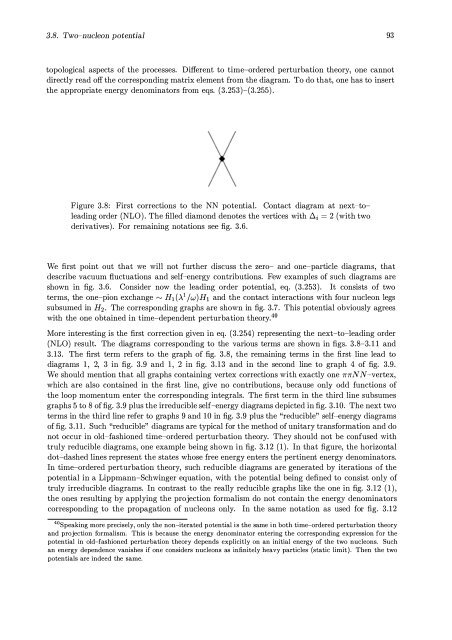The Nucleon-Nucleon Interaction in a Chiral Effective Field Theory
The Nucleon-Nucleon Interaction in a Chiral Effective Field Theory
The Nucleon-Nucleon Interaction in a Chiral Effective Field Theory
You also want an ePaper? Increase the reach of your titles
YUMPU automatically turns print PDFs into web optimized ePapers that Google loves.
3.8. Two-nucleon potential 93<br />
topological aspects of the processes. Different to time-ordered perturbation theory, one cannot<br />
directly read off the correspond<strong>in</strong>g matrix element from the diagram. To do that, one has to <strong>in</strong>sert<br />
the appropriate energy denom<strong>in</strong>ators from eqs. (3.253)-(3.255).<br />
Figure 3.8: First corrections to the NN potential. Contact diagram at next-tolead<strong>in</strong>g<br />
order (NLO). <strong>The</strong> filled diamond denotes the vertices with L::.i = 2 (with two<br />
derivatives). For rema<strong>in</strong><strong>in</strong>g notations see fig. 3.6.<br />
We first po<strong>in</strong>t out that we will not furt her discuss the zero- arid one-particle diagrams, that<br />
describe vacuum fiuctuations and self-energy contributions. Few examples of such diagrams are<br />
shown <strong>in</strong> fig. 3.6. Consider now the lead<strong>in</strong>g order potential, eq. (3.253). It consists of two<br />
terms, the one-pion exchange rv H1 ().. 1 /w)H1 and the contact <strong>in</strong>teractions with four nucleon legs<br />
subsumed <strong>in</strong> H2 . <strong>The</strong> correspond<strong>in</strong>g graphs are shown <strong>in</strong> fig. 3.7. This potential obviously agrees<br />
with the one obta<strong>in</strong>ed <strong>in</strong> time-dependent perturbation theory.40<br />
More <strong>in</strong>terest<strong>in</strong>g is the first correction given <strong>in</strong> eq. (3.254) represent<strong>in</strong>g the next-to-lead<strong>in</strong>g order<br />
(NLO) result. <strong>The</strong> diagrams correspond<strong>in</strong>g to the various terms are shown <strong>in</strong> figs. 3.8-3.11 and<br />
3.13. <strong>The</strong> first term refers to the graph of fig. 3.8, the rema<strong>in</strong><strong>in</strong>g terms <strong>in</strong> the first l<strong>in</strong>e lead to<br />
diagrams 1, 2, 3 <strong>in</strong> fig. 3.9 and 1, 2 <strong>in</strong> fig. 3.13 and <strong>in</strong> the second l<strong>in</strong>e to graph 4 of fig. 3.9.<br />
We should mention that all graphs conta<strong>in</strong><strong>in</strong>g vertex corrections with exactly one 7r7r N N -vertex,<br />
which are also conta<strong>in</strong>ed <strong>in</strong> the first l<strong>in</strong>e, give no contributions, because only odd functions of<br />
the loop moment um enter the correspond<strong>in</strong>g <strong>in</strong>tegrals. <strong>The</strong> first term <strong>in</strong> the third l<strong>in</strong>e subsumes<br />
graphs 5 to 8 offig. 3.9 plus the irreducible self-energy diagrams depicted <strong>in</strong> fig. 3.10. <strong>The</strong> next two<br />
terms <strong>in</strong> the third l<strong>in</strong>e refer to graphs 9 and 10 <strong>in</strong> fig. 3.9 plus the "reducible" self-energy diagrams<br />
offig. 3.11. Such "reducible" diagrams are typical for the method ofunitary transformation and do<br />
not occur <strong>in</strong> old-fashioned time-ordered perturbation theory. <strong>The</strong>y should not be confused with<br />
truly reducible diagrams, one example be<strong>in</strong>g shown <strong>in</strong> fig. 3.12 (1). In that figure, the horizontal<br />
dot-dashed l<strong>in</strong>es represent the states whose free energy enters the pert<strong>in</strong>ent energy denom<strong>in</strong>ators.<br />
In time-ordered perturbation theory, such reducible diagrams are generated by iterations of the<br />
potential <strong>in</strong> a Lippmann-Schw<strong>in</strong>ger equation, with the potential be<strong>in</strong>g def<strong>in</strong>ed to consist only of<br />
truly irreducible diagrams. In contrast to the really reducible graphs like the one <strong>in</strong> fig. 3.12 (1),<br />
the ones result<strong>in</strong>g by apply<strong>in</strong>g the projection formalism do not conta<strong>in</strong> the energy denom<strong>in</strong>ators<br />
correspond<strong>in</strong>g to the propagation of nucleons only. In the same notation as used for fig. 3.12<br />
4° Speak<strong>in</strong>g more precisely, only the non-iterated potential is the same <strong>in</strong> both time-ordered perturbation theory<br />
and projection formalism. This is because the energy denom<strong>in</strong>ator enter<strong>in</strong>g the correspond<strong>in</strong>g expression for the<br />
potential <strong>in</strong> old-fashioned perturbation theory depends explicitly on an <strong>in</strong>itial energy of the two nucleons. Such<br />
an energy dependence vanishes if one considers nucleons as <strong>in</strong>f<strong>in</strong>itely heavy particles (static limit). <strong>The</strong>n the two<br />
potentials are <strong>in</strong>deed the same.












